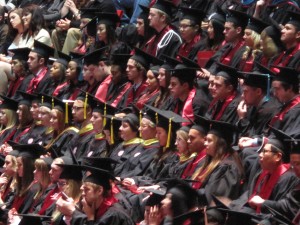How Increasing Enrollment Is Straining Finances At Indiana's Public Colleges

Kyle Stokes / StateImpact Indiana
Indiana University graduates attend the Bloomington campus' winter commencement ceremonies.
Let’s paraphrase an argument you’ve heard on StateImpact before:
If you’re an Indiana state lawmaker (at least in the current majority), you probably think the state’s public universities are doing too little to keep a student’s cost of attendance down. The price of a college education is rising faster than the rate of inflation, you argue.
If you’re a public university in Indiana, on the other hand, you probably think decreasing state appropriations left you no choice but to raise tuition and fees more than state lawmakers would’ve wanted.
A recently-released report hints at a fundamental cause for the financial strain at Indiana’s public universities: a surge in enrollment in the past decade, brought on in part by the most recent economic downturn.
The report shows Indiana’s colleges and universities have seen a 16 percent increase in enrollment since 2007. As the staff of SHEEO, which represents state higher education officials, write in the report:
Higher education has historically experienced large increases in enrollment during times of economic recession, and this tendency has been accentuated by the growing economic importance of postsecondary education…
Students and their families have persistently been asked to shoulder a larger share of the cost of public higher education in the United States. The depth and breadth of the 2008 recession and the challenges of financing health care and retirement costs for an aging population leave little room for hope that trend can easily be reversed. While serving continuing enrollment demand is an urgent fiscal priority, health care inflation and retirement expenses are also significant cost drivers in higher education.
In constant 2011 dollars, the report shows, Indiana paid roughly the same amount of money (in tuition and government funding) for higher education per student* last year as in 2002. But since 2002, several things have happened:
- Enrollment has grown 31.5 percent. In 2002, Indiana universities enrolled the equivalent of 203,000 students (*the report counts students in “Full-Time Equivalents”). By 2011, they enrolled more than 267,000 students, mirroring the 33 percent jump in national enrollment.
- State and local government appropriations for higher education have decreased. In 2002, the state spent more than $6,100 per student (in constant 2011 dollars). Last year, the state spent roughly $4,700 per student.
- The amount students are spending on tuition has increased. Students spent $5,500 on tuition in 2002 (again, in constant 2011 dollars). Last year, students spent nearly $6,700 on tuition. (We’ve attached a chart below so you can see for yourself).
The report also points out the recession has choked off state revenues. Long-term, it shows that in real dollars, total state appropriations for higher education have increased over the past decade.
“In 1986, state and local governments combined provided $31.4 billion in direct support for general operating expenses of public and independent higher education institutions. This investment increased to $47.8 billion in 1996, $77 billion in 2006, and $88.8 billion by 2008,” the report’s authors write.
Here are two charts from the report, showing the cost of public universities in the United States and Indiana — and who’s paying that cost. (Read the full report here.)
[documentcloud url=https://www.documentcloud.org/documents/327809-sheeo-higher-education-report.html format=normal sidebar=false ]

